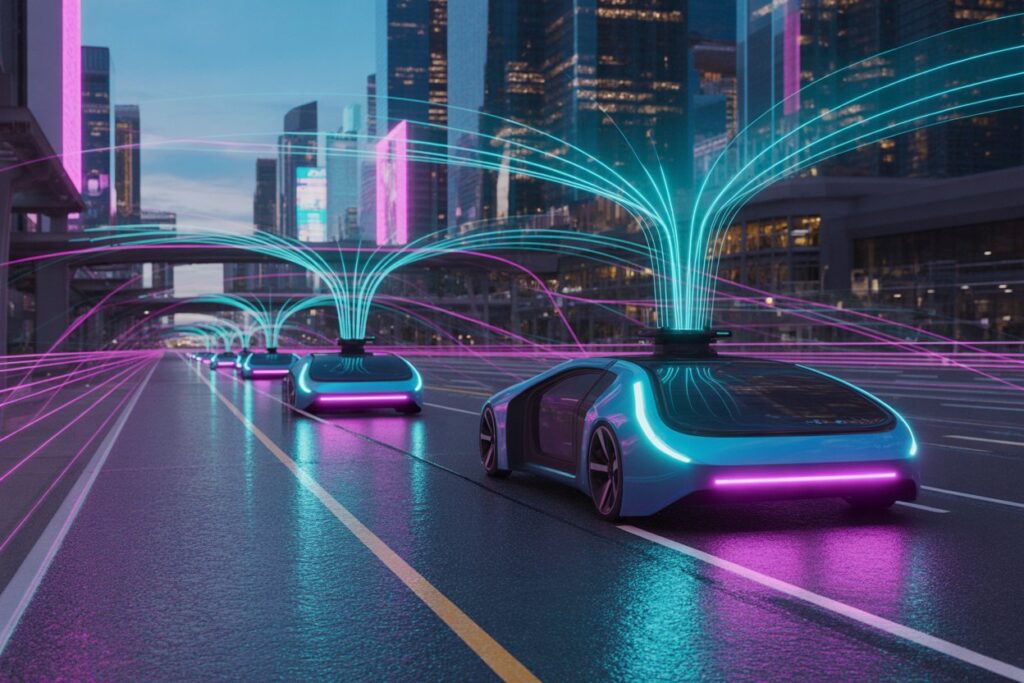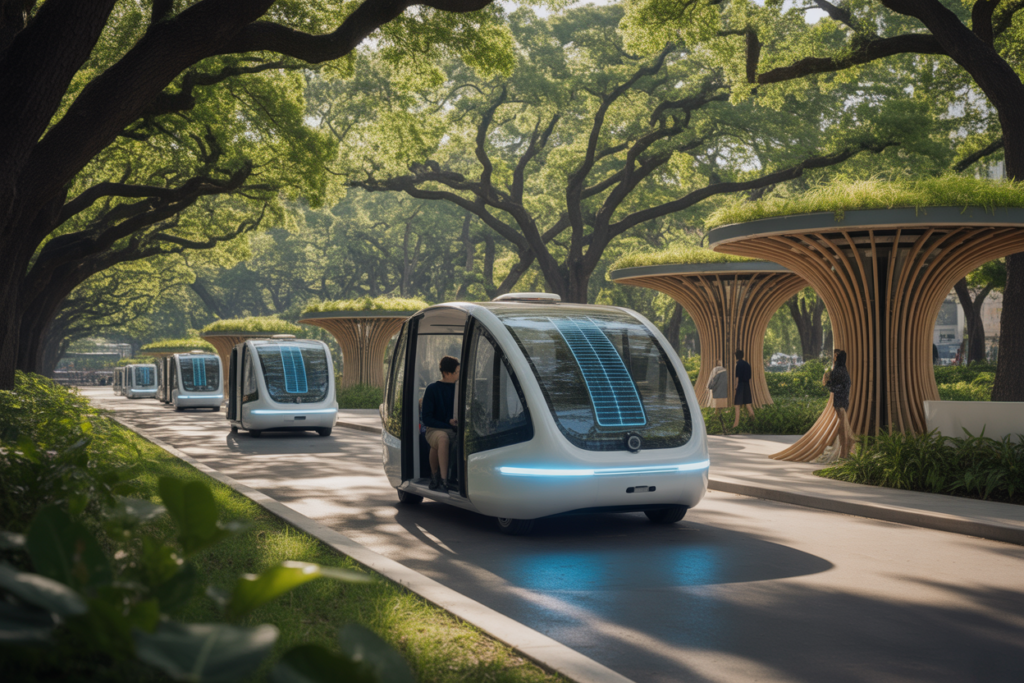Autonomous vehicles (AVs), also known as self-driving cars, represent one of the most transformative technologies of the 21st century, promising to revolutionize transportation by enhancing safety, efficiency, and accessibility. These vehicles use advanced sensors, artificial intelligence (AI), and connectivity to navigate roads without human intervention, potentially reducing the 1.3 million annual global road deaths caused by human error, according to the World Health Organization. As of October 2025, the autonomous vehicle market has reached a valuation of $273.75 billion, with projections to surge to $4,450.34 billion by 2034 at a compound annual growth rate (CAGR) of 36.3%, driven by AI advancements, sensor innovations, and supportive regulations. Companies like Tesla, Waymo, and Baidu are leading deployments, from robotaxis in urban centers to autonomous trucks on highways. This article explores the fundamentals, advancements, applications, challenges, and future of autonomous vehicles, highlighting their role in sustainable mobility.
The Fundamentals of Autonomous Vehicles
What Are Autonomous Vehicles?
Autonomous vehicles operate across six levels of automation defined by the Society of Automotive Engineers (SAE): Level 0 (no automation) to Level 5 (full autonomy, no steering wheel or pedals needed). At their core, AVs rely on:
- Sensors: LiDAR, radar, cameras, and ultrasonic sensors detect surroundings.
- AI and Machine Learning: Process data for decision-making, using neural networks for object recognition and path planning.
- Connectivity: Vehicle-to-Everything (V2X) communication shares data with infrastructure, other vehicles, and clouds.
- Actuators: Control steering, braking, and acceleration.
Level 3 and 4 systems, now common in premium models, handle most driving tasks but may require human oversight in complex scenarios.
The Evolution of Autonomous Vehicles
The journey began with early experiments like DARPA’s 2004 Grand Challenge, where no vehicle completed the course. By 2010, Google’s self-driving car project (now Waymo) logged millions of miles. The 2020s accelerated progress: Tesla’s Full Self-Driving (FSD) software reached Level 2+ in 2022, and by 2025, Level 3 systems are standard in Europe and North America for highway driving. Regulatory milestones, like China’s 2025 Level 3 approvals and the U.S. NHTSA’s testing waivers, have spurred commercial deployments. Today, AVs blend with electric vehicles (EVs), with Tesla’s Cybercab exemplifying the autonomous EV trend.
Major Advancements in Autonomous Vehicles
1. AI and Sensor Fusion
AI breakthroughs, including generative AI for synthetic data generation, address data scarcity for rare scenarios. NVIDIA’s DRIVE Thor SoC, unveiled at CES 2025, delivers unprecedented computing power for real-time sensor fusion, processing LiDAR and camera data at 1,000 teraflops. Startups like AutoL develop fog-penetrating LiDAR, extending detection to 300 meters. These enable Level 4 autonomy in adverse weather.
Applications:
- Predictive Analytics: AI anticipates hazards, reducing accidents by 90% in simulations.
- Adaptive Learning: Vehicles improve via over-the-air (OTA) updates, like Tesla’s FSD v12.5 in 2025.
2. Connectivity and V2X Communication
5G and emerging 6G enable low-latency V2X, allowing vehicles to share traffic data. HERE Technologies’ 2025 maps provide curvature and elevation details for proactive adjustments. In Europe, C-V2X pilots reduce congestion by 15%.
Case Study: Waymo’s 2025 Phoenix expansion uses V2X to integrate with traffic signals, achieving 250,000 weekly rides with 99.9% uptime.

3. Edge Computing and High-Resolution Mapping
Edge computing processes data onboard, minimizing latency to 1ms. High-definition (HD) maps from companies like Mobileye update dynamically via crowdsourcing. In 2025, multi-gigabit interfaces like 2.5Gb Ethernet handle sensor data floods.
Impact: Reduces reliance on cloud, enhancing privacy and reliability in remote areas.
4. Integration with Electric Vehicles
Autonomous EVs dominate, with Tesla’s Cybercab launching in Austin in June 2025 for paid rides. Geely’s Zeekr, partnered with Waymo, features full autonomy and 320-mile range.
Applications:
- Sustainability: AVs optimize routes, cutting emissions by 20%.
- Ride-Hailing: Baidu’s Apollo Go in Wuhan plans 500 vehicles by year-end.
5. Robotaxis and Autonomous Trucks
Robotaxis lead commercialization: Waymo serves 250,000 riders weekly in multiple U.S. cities. Autonomous trucks, like Aurora’s Houston-Dallas corridor, address driver shortages.
Case Study: Pony.ai’s Gen-7 Robotaxi, unveiled in 2025, cuts hardware costs by 70% for Level 4 deployment.
Applications of Autonomous Vehicles
1. Urban Mobility and Ride-Hailing
Robotaxis transform public transport. In 2025, Uber integrates Waymo in Austin and Atlanta, enhancing accessibility for non-drivers. Shared mobility grows at 30.32% CAGR, per Mordor Intelligence.
2. Logistics and Delivery
AVs optimize last-mile delivery. Starship Technologies’ robots serve 24 U.S. campuses, while Amazon tests drone deliveries. Logistics applications project 14% CAGR.

3. Public Transportation and Shuttles
Autonomous shuttles, like those in Singapore’s Smart Nation, reduce urban congestion by 15%. Europe’s robobuses expand, led by Chinese firms.
Case Study: Toyota’s e-Palette shuttles at Tokyo 2020 Olympics delivered supplies autonomously.
4. Freight and Long-Haul Trucking
Autonomous trucks enable 24/7 operations. Aurora’s 2025 safety report validates Level 4 trucking over 500-mile ranges. McKinsey predicts $300-400 billion revenue by 2035.
5. Military and Specialized Uses
Military AVs, like drones for surveillance, enhance reconnaissance. Civilian offshoots include mining haul trucks from Caterpillar.

6. Healthcare and Elderly Mobility
AVs provide independence for seniors via on-demand rides. Jordan’s 2023 study shows 70% positive perceptions among youth.
Challenges in Autonomous Vehicles
1. Technical and Safety Hurdles
Edge cases, like fog or erratic pedestrians, challenge AI. 2025 incidents, including Zoox’s braking recall, highlight software flaws. Simulations like MetaDrive aid testing, but real-world validation lags.
2. Regulatory and Ethical Issues
Regulations vary: U.S. state-by-state approvals slow deployment, while China’s policies accelerate it. Ethical dilemmas, like trolley problems, require AI explainability. UK’s 2027 full autonomy delay underscores caution.
3. Cybersecurity and Privacy
V2X exposes vehicles to hacks. 2025 breaches emphasize encryption needs. Data from sensors raises privacy concerns under GDPR.
4. Economic and Infrastructure Barriers
High costs ($5,000+ per vehicle for L3/L4) limit accessibility. Infrastructure upgrades, like smart roads, demand billions.
5. Public Acceptance and Job Displacement
Surveys show 40% skepticism due to safety fears. Trucking jobs (3.5 million in U.S.) face disruption, requiring reskilling.
The Future of Autonomous Vehicles
1. Level 5 Autonomy and Mass Adoption
By 2030, Level 5 AVs could penetrate 10% of markets, per Gartner. Apple’s rumored 2026 foldable integrates L4 autonomy.
2. Integration with Smart Cities and 6G
6G will enable holographic interfaces and fleet coordination. Singapore’s pilots forecast 85% coverage by 2030.
3. Sustainable and Inclusive Mobility
AV-EV synergy cuts emissions 40%. Inclusive designs aid disabled users, boosting accessibility.
Prediction: AVs could add $7 trillion to global GDP by 2050, per McKinsey, through efficiency gains.
Societal Implications
AVs promise safer roads (90% accident reduction) and economic growth (300,000 U.S. jobs by 2030). They enhance equity for rural and elderly populations but risk exacerbating urban-rural divides without infrastructure equity. Ethical AI must prioritize vulnerable road users, and policies should fund reskilling for displaced workers. Environmentally, AVs optimize traffic, slashing fuel use by 20%, aiding net-zero goals.
Conclusion
Autonomous vehicles in 2025 stand at a pivotal juncture, with AI, sensors, and connectivity propelling Level 4 deployments in robotaxis and trucks. Applications in logistics, urban mobility, and freight underscore their versatility, while challenges like regulation and cybersecurity demand collaborative solutions. From Waymo’s urban fleets to Tesla’s Cybercab, AVs are no longer science fiction but a tangible evolution toward safer, smarter transport. By addressing ethical and infrastructural hurdles, society can harness AVs for inclusive, sustainable mobility, unlocking a future where roads prioritize people over drivers.
Leave a Reply